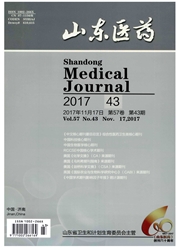

 中文摘要:
中文摘要:
目的探讨七氟烷预处理联合后处理对大鼠肺缺血再灌注损伤(IRI)的保护作用及其机制。方法选择成年雄性SD大鼠54只,采用随机数字表法将其分为3组:假手术组(S组)仅游离左肺门,不阻断;肺缺血再灌注组(I/R组)采用阻断左肺门45 min后再灌注120 min的方法制备IRI模型;七氟烷预处理联合后处理组(SP组)阻断左肺门前吸入2.1%七氟烷,阻断左肺门45 min,于松开血管夹即刻再次吸入2.1%七氟烷30 min制备IRI模型。分别于再灌注30、60和120 min时随机取6只大鼠处死,取肺组织,测定湿/干重比(W/D比),比色法检测超氧化物歧化酶(SOD)的活性,ELISA法测定TNF-α表达,RT-PCR法测定血管紧张素转化酶(ACE)mRNA表达。光镜下观察肺组织病理学检查结果。结果与S组相比,I/R组和SP组再灌注各时点肺组织W/D比、TNF-α水平及ACE mRNA表达均升高(P均<0.05),SOD活性均降低(P均<0.05);与I/R组比较,SP组再灌注各时点肺组织W/D比、TNF-α水平及ACE mRNA表达均降低(P均<0.05),SOD活性均升高(P均<0.05)。光镜下SP组肺组织病理学损伤较I/R组减轻。结论七氟烷预处理联合后处理可能通过抑制氧化应激反应及炎症反应对大鼠肺缺血再灌注损伤发挥保护作用。
 英文摘要:
英文摘要:
Objective To explore the protective effect of sevoflurane preprocessing combined with postprocessing on lung ischemia-reperfusion injury ( IRI) in rats and its mechanism .Methods Fifty-four adult male SD rats were randomly divided into three groups.Rats in the sham operation group (group S) only received dissociation of the left pulmonary hi-lum without blocking .The lung ischemia-reperfusion group ( I/R group) received blocking the left pulmonary hilum for 45 minutes and reperfusion for 120 minutes for establishment of the rat model of IRI .The sevoflurane preprocessing combined with postprocessing group (SP group) received inhalation of 2.1%sevoflurane for 30 minutes prior to blocking the left pul-monary hilum, then blocking the left pulmonary hilum for 45 minutes, and inhaling 2.1%sevoflurane again for 30 minutes in the immediate release of the vascular clamp for establishment of the IRI model .Six rats were randomly sacrificed after reperfusion for 30, 60 and 120 minutes, respectively.Their lung tissues were taken for measuring the wet-to-dry weight ra-tio ( W/D ratio ) .The superoxide dismutase ( SOD ) activity was detected by colorimetry .The tumor necrosis factor-α( TNF-α) level was detected by enzyme-linked immunosorbent assay ( ELISA) .The mRNA expression of angiotensin-con-verting enzyme ( ACE) was measured by RT-PCR.The lung histopathology results were observed under the light micro-scope.Results Compared with group S , the W/D ratios, TNF-αlevels and ACE mRNA expression in the lung tissues were increased at each reperfusion time point in the I /R group and SP group (all P<0.05), and the SOD activities were decreased (all P<0.05).Compared with the I/R group, the W/D ratios, TNF-αlevels and ACE mRNA expression in the lung tissues were decreased at each reperfusion time point in the SP group (all P<0.05), and the SOD activities were elevated (all P<0.05).Under the light microscope, the lung histopathological injuries in the SP group were alleviated as compared with those of the I/R group.Conclusion S
 同期刊论文项目
同期刊论文项目
 同项目期刊论文
同项目期刊论文
 期刊信息
期刊信息
